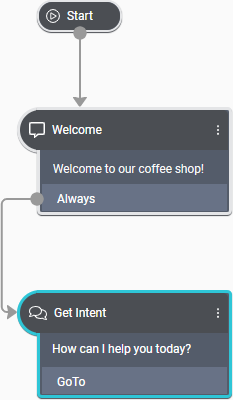Prompting the user
Prompts (called “messages” in Mix) permit an application to interact with your users. Not only do they set the tone of the application, they also direct users toward the fulfillment of their goals.

For example, messages enable an application to:
- Greet users
- Convey the system’s readiness to perform an action or command
- Ask questions of users
- Provide information to users
- Respond to what a user says or does, in the most specific and relevant way to help them accomplish what they want to do
With the help of the sample dialog flows you defined in Five steps to planning your app, you should have a good understanding of what types of messages you will need. For example:
- Initial message comprised of a greeting and/or an open-ended question such as “Welcome to our coffee shop!” or “How can I help you today?” (The example shows how you might start such a conversation in Mix.dialog.)
- Open-ended questions at the start of specific dialogs to invite users to express their intent, which may be focused to guide the user, such as “What beverage would you like? Our specialty is coffee.”
- Error recovery responses in the event of silence, nomatches, failure to return interpretation results, and system/application errors. See Handling errors and ambiguity.
- Confirmation messages in the form of closed questions that require a yes- or no-type response such as “I’ll go ahead and place the order now, okay?” See Requesting confirmation.
Consider how you want to interact with the user. For example, in the form of:
- Text to be rendered using text-to-speech (TTS)
- Text to be visually displayed, for example, in a chat
- Audio file
- Buttons or other interactive elements, for example, in a web or multi-channel application
- DTMF in voice (IVR) applications
Your dialog design may, after all, support multiple channels (such as IVR/Voice or Digital) and use channel-specific messages as needed. Each channel, in turn, will support multiple modalities (such as rich text, audio, TTS, interactivity, DTMF).
Feedback
Was this page helpful?
Glad to hear it! Please tell us how we can improve.
Sorry to hear that. Please tell us how we can improve.